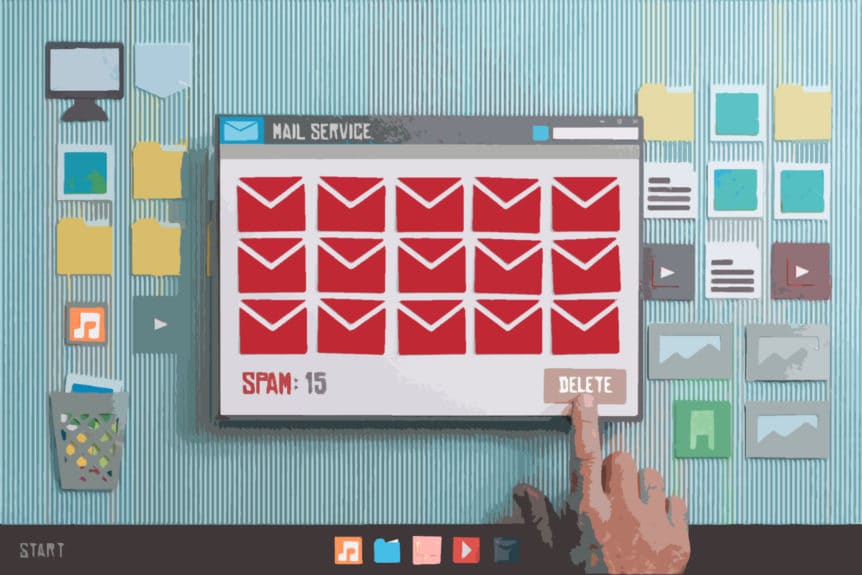We are a small business and send out a regular monthly newsletter to our clients and prospects. We have seeded our list with several team members’ personal and professional email addresses. However, we find that our company newsletters end up in our team members’ spam folders – both the personal and professional email addresses. We are worried this is impacting our customers as well. What can we do to avoid ending up as spam? – Jo, Fort Collins, Colorado
Answer:
There are many different factors which directly affect your emails as being tagged as spam. The number one reason is your subject line. Automated software scans and searches for triggers from incoming emails, subsequently identifying potential spam. Besides the enhancement of technology, the second line of defense is our personal filter and common sense. Basic cyber self-protection dictates that we recognize and avoid emails we deem unsafe. In fact, OptinMonster reports that 69% of recipients report an e-mail as spam based on the subject line alone.
Subject Lines
When creating your newsletter subject lines, refer to our extensive SPAM Trigger Words resource for the words and phrases to avoid. In addition, make a note of any subject lines you feel are spammy and add them to the cache. If you think the subject line is spammy, most likely your audience will as well. Make sure you aren’t using any triggers that will get you in trouble.
As you go through the list in the resource, you will notice what appears to be duplicates. However, there are differences. Some trigger words or phrases are upper and lower case, others all upper case, some include punctuation, and others have altered formatting. Using these types of tricks does not get you around spam filters. It simply adds to the growing bank of trigger words and phrases.
Avoiding trigger words is the one of many best practices you want to exercise when writing your subject lines. Don’t use all caps or excessive punctuation, as both of these will activate the spam detectors. Exclamation points, especially when used with question marks, immediately set off spam alarm bells. Using single apostrophes are also a no-no.
The beginning of your subject line should not use Re: or Fwd:, because spam filters recognize this deception for what it is when the email is coming in the first time. It’s a surefire way to land in the spam folder. So is starting your email subject line with an active question designed to elicit a specific response. You will find “Do you like/want/have…?” in the comprehensive resource of trigger words.
Spam Factors
While your subject line is the primary spam determining factor, as mentioned above, it is not the only one. Always consider and critically review the content within your email, too. You want to avoid negative behaviors and sentiments. Picture the stereotypical, sleazy used-car salesman. Makes your skin crawl, right? Things that appear too good to be true, unbelievable, manipulative, and shady will all evoke distaste or disgust. No one likes associating with unsavory characters. Along with sounding too needy, all of these behaviors will turn off your audience, increase the likelihood of being identified as spam, and explode your unsubscribe rate.
Other spam detecting aspects are the elements within your email. These include using more than 3 font colors, with special attention to the use of red. Here at Petite2Queen, our primary branding color is red, and we must pay careful attention to how it is used within our email content to avoid being “red flagged” by spam detectors. Another detail we watch is the ratio of text versus image content. A 60:40 text-to-image ratio is considered optimal.
Use links to provide your audience access to videos, direct media, or forms. This habit will help avoid being labeled as spam and improve overall deliverability. Rich media, such as JavaScript or incompetent HTML coding, will both alert spam detectors. And never start your marketing email content with “Dear.” It’s fatal and you will be tossed into the spam abyss.
Unsubscribe Options
Our last tips to avoid the spam dungeon start with including a clear “Unsubscribe” button. Consider giving your audience the option to opt out of your regular newsletter, while still staying on your list for special announcements, events, or offers. It will allow your tribe to choose their engagement level rather than losing them all together. Second, it’s a good idea to ask your new audience members to whitelist your domain in your initial welcome email. Finally, utilizing a reputable third-party email service provider will significantly reduce the chance of bulk emails being labeled as spam. Plus, they offer a wealth of resources to improve your marketing emails.
Spam Score
With unsolicited junk mail at 86% of all global email traffic, you can understand why your legitimate emails could end up in your recipient’s spam folder. While following the best practices outlined above, there are also excellent tools readily available to verify your email deliverability and spam score. Those with free options include:
Open Rates
There is one last piece of advice that will be instrumental in improving your email open rate. Remember, one of the most important aspects of your email campaign is the subject line. If the subject line sucks, no one will even open your email. Subject lines that are too long will trigger spam detectors, too. An excellent resource is provided by Co-Scheduler. Their “Email Subject Line Tester” is a truly indispensable tool to help you write rocking subject lines and stay away from the spam dungeon. Another excellent resource is Respona’s article, “18 Follow-Up Email Subject Lines from Real Campaigns.”

Lynn Whitbeck is the co-founder and President of Petite2Queen. She is focused on identifying and evaluating opportunities for women at work, helping them define their personal roadmap. She dedicates herself to delivering tools and insights, embracing visualization of the big picture, and identifying and implementing the minutiae of detail. Lynn aims to share lessons learned along her journey and enable positive uplift for women.

